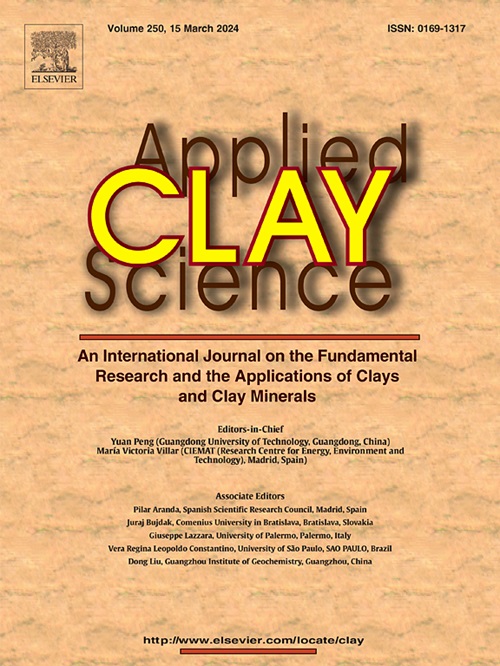亚马逊铝土矿废粘土沸石制备钡、锶铈陶瓷及表征
IF 5.3
2区 地球科学
Q2 CHEMISTRY, PHYSICAL
引用次数: 0
摘要
本研究探索了利用亚马逊地区的一种采矿残渣——铝土矿洗土(BWC)作为合成沸石的原料,然后将其转化为钡和锶陶瓷。BWC中含有丰富的三长石和高岭石,由于其高铝和硅含量而显示出巨大的潜力。用1 M NaOH在350℃下碱性活化4 h合成沸石,然后在100℃下水热处理24 h,再与Ba2+和Sr2+阳离子进行离子交换,所得材料在1200℃下进行热处理。结果表明:形成了单斜晶钡石,结晶度高,而Sr-celsian则发生了部分转化,保留了霞石作为次级相。单斜斜钡钡表现出优异的力学性能,在低硅含量的组合物中抗压强度达到15.9 MPa,而Sr-celsian的抗压强度达到11.94 MPa。总之,本研究突出了生物wc作为先进陶瓷生产有价值和可持续的前体的潜力。本文章由计算机程序翻译,如有差异,请以英文原文为准。
Synthesis and characterization of Ba and Sr celsian ceramics from zeolites obtained from amazonian bauxite waste clay
This study explored the use of bauxite washing clay (BWC), a mining residue from the Amazon region, as a raw material for the synthesis of zeolites, followed by their conversion into barium and strontium celsian ceramics. The BWC, rich in gibbsite and kaolinite, demonstrated significant potential due to its high aluminum and silicon content. Zeolites were synthesized through alkaline activation with 1 M NaOH at 350 °C for 4 h, followed by hydrothermal treatment at 100 °C for 24 h. Ion exchange with Ba2+ and Sr2+ cations was then performed, and the obtained materials were thermally treated at 1200 °C. The results showed the formation of monoclinic barium celsian with high crystallinity, while Sr-celsian exhibited partial conversion, retaining nepheline as a secondary phase. Monoclinic barium celsian exhibited superior mechanical properties, achieving a compressive strength of 15.9 MPa in compositions with lower silica content, whereas Sr-celsian reached 11.94 MPa. In conclusion, this study highlights the potential of BWC as a valuable and sustainable precursor for advanced ceramic production.
求助全文
通过发布文献求助,成功后即可免费获取论文全文。
去求助
来源期刊

Applied Clay Science
地学-矿物学
CiteScore
10.30
自引率
10.70%
发文量
289
审稿时长
39 days
期刊介绍:
Applied Clay Science aims to be an international journal attracting high quality scientific papers on clays and clay minerals, including research papers, reviews, and technical notes. The journal covers typical subjects of Fundamental and Applied Clay Science such as:
• Synthesis and purification
• Structural, crystallographic and mineralogical properties of clays and clay minerals
• Thermal properties of clays and clay minerals
• Physico-chemical properties including i) surface and interface properties; ii) thermodynamic properties; iii) mechanical properties
• Interaction with water, with polar and apolar molecules
• Colloidal properties and rheology
• Adsorption, Intercalation, Ionic exchange
• Genesis and deposits of clay minerals
• Geology and geochemistry of clays
• Modification of clays and clay minerals properties by thermal and physical treatments
• Modification by chemical treatments with organic and inorganic molecules(organoclays, pillared clays)
• Modification by biological microorganisms. etc...
 求助内容:
求助内容: 应助结果提醒方式:
应助结果提醒方式:


